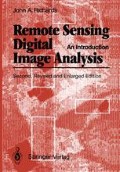Abstract
Classification cost increases with the number of features used to describe pixel vectors in multispectral space — i. e. with the number of spectral bands associated with a pixel. For classifiers such as the parallelepiped and minimum distance procedures this is a linear increase with features; however for maximum likelihood classification, the procedure most often preferred, the cost increase with features is quadratic. Therefore it is sensible economically to ensure that no more features than necessary are utilised when performing a classification. Features which do not aid discrimination, by contributing little to the separability of spectral classes, should be discarded since they will represent a cost burden. Removal of least effective features is referred to as feature selection, this being one form of feature reduction. The other is to transform the pixel vector into a new set of co-ordinates in which the features that can be removed are made more evident. Both procedures are considered in some detail in this Chapter.
Access this chapter
Tax calculation will be finalised at checkout
Purchases are for personal use only
Preview
Unable to display preview. Download preview PDF.
References for Chapter 10
N. A. Campbell and W. R. Atchley, 1981: The Geometry of Canonical Variate Analysis. Systematic Zoology, 30, 268–280.
R.O. Duda & P.E. Hart, 1973: Pattern Classification and Scene Analysis, N.Y., Wiley.
W. Eppler, 1976: Canonical Analysis for Increased Classification Speed and Channel Selection, IEEE Trans. Geoscience Electronics, GE-14.
IBM, 1976: ER-MAN II User’s Manual, Program Number 5790-ABR, Belgium, IBM.
S.K. Jensen & F.A. Waltz, 1979: Principal Components Analysis and Canonical Analysis in Remote Sensing, Proc. American Soc. of Photogrammetry 45th Ann. Meeting.
T. Kailath, 1967: The Divergence and Bhattacharyya Distance Measures in Signal Selection, IEEE Trans. Communication Theory, COM-15, 52–60.
P.W. Mausel, W.J. Kramber and J.K. Lee, 1990: Optimum Band Selection for Supervised Classification of Multispectral Data. Photogrammetric Engineering and Remote Sensing, 56, 55–60.
B.F. Merembeck, F.Y. Borden, M.H. Podwysocki & D.N. Applegate, 1977: Application of Canonical Analysis to Multispectral Scanner Data, Proc. 14th Symp. Applications of Computer Methods in the Mineral Industry, N.Y., AIMMPE.
B.F. Merembeck & B.J. Turner, 1980: Directed Canonical Analysis and the Performance of Classifiers under its Associated Linear Transformation, IEEE Trans. Geoscience and Remote Sensing, GE-18, 190–196.
V. I. Myers, 1983: Remote Sensing Applications in Agricuhure. In R. N. Colwell (Ed.) Manual of Remote Sensing, 2e, American Soc. of Photogrammetry, Falls Church.
T.L. Phillips (Ed.), 1973: LARSYS Version 3 Users Manual, Laboratory for Applications of Remote Sensing, Purdue University, West Lafayette.
H. Seal, 1964: Multivariate Statistical Analysis for Biologists. London, Menthuen.
P.H. Swain & S.M. Davis, (Eds.), 1978: Remote Sensing: The Quantitative Approach, N.Y., McGraw-Hill.
P.H. Swain & R.C. King, 1973: Two Effective Feature Selection Criteria for Multispectral Remote Sensing, Proc. First Int. Joint Conf. on Pattern Recognition, 536–540, November.
P. H. Swain, T. V. Robertson & A. G. Wacker, 1971: Comparison of Divergence and B-Distance in Feature Selection, Information Note 020871, Laboratory for Applications of Remote Sensing, Purdue University, West Lafayette.
M.M. Tatsuoka, 1971: Multivariate Analysis, N.Y., Wiley.
A. G. Wacker, 1971: The Minimum Distance Approach to Classification, Ph. D. Thesis, Purdue University, West Lafayette.
Author information
Authors and Affiliations
Rights and permissions
Copyright information
© 1993 Springer-Verlag Berlin Heidelberg
About this chapter
Cite this chapter
Richards, J.A. (1993). Feature Reduction. In: Remote Sensing Digital Image Analysis. Springer, Berlin, Heidelberg. https://doi.org/10.1007/978-3-642-88087-2_10
Download citation
DOI: https://doi.org/10.1007/978-3-642-88087-2_10
Publisher Name: Springer, Berlin, Heidelberg
Print ISBN: 978-3-540-58219-9
Online ISBN: 978-3-642-88087-2
eBook Packages: Springer Book Archive

